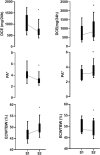Association between phase angle and daily creatinine excretion changes in critically ill patients: an approach to muscle mass
- PMID: 39844897
- PMCID: PMC11753204
- DOI: 10.3389/fphys.2024.1508709
Association between phase angle and daily creatinine excretion changes in critically ill patients: an approach to muscle mass
Abstract
Assessing muscle mass in critically ill patients remains challenging. This retrospective cohort study explores the potential of phase angle (PA°) derived from bioelectrical impedance analysis (BIA) as a surrogate marker for muscle mass monitoring by associating it with daily creatinine excretion (DCE), a structural and metabolic muscle mass marker. In 20 ICU patients, we observed a linear relationship between PA° and DCE at initial (S1) and follow-up (S2) points, with Rho values of 0.78 and 0.65, respectively, as well as between their percentage changes (Rho = 0.80). Multivariate analysis confirmed a strong association between changes in PA° and DCE (adjusted R2 of 0.73), while changes in the extracellular water to total body water (ECW/TBW) ratio showed no significant association. This study establishes a relationship between a BIA-derived independent-weight parameter and DCE, highlighting the potential of PA° for muscle mass monitoring during acute changes, such as those seen in ICU settings. Integrating PA° into clinical practice could provide a non-invasive and reliable tool to enhance muscle assessment and support targeted interventions in critically ill patients.
Keywords: bioelectrical impedance analysis; critical care; daily creatinine excretion; muscle mass; phase angle.
Copyright © 2025 Vargas-Errázuriz, Dreyse, López, Cano-Cappellacci, Graf and Guerrero.
Conflict of interest statement
The authors declare that the research was conducted in the absence of any commercial or financial relationships that could be construed as a potential conflict of interest.
Figures


References
-
- Barnett A., Bagno S. (1935). The physiological mechanisms involved in the clinical measure of phase angle: circuits simulating the phase angle properties of the body; correlations with experimental findings in normal and pathological states. Am. J. Physiology-Legacy Content 114 (2), 366–382. 10.1152/ajplegacy.1935.114.2.366 - DOI
LinkOut - more resources
Full Text Sources

